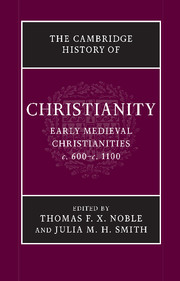Book contents
- Frontmatter
- Introduction: Christendom, c. 600
- Part I Foundations: Peoples, Places, and Traditions
- 1 Late Roman Christianities
- 2 The emergence of Byzantine Orthodoxy, 600–1095
- 3 Beyond empire I: Eastern Christianities from the Persian to the Turkish conquest, 604–1071
- 4 Beyond empire II: Christianities of the Celtic peoples
- 5 Germanic Christianities
- 6 Slav Christianities, 800–1100
- Part II Christianity in Confrontation
- Part III Christianity in the Social and Political Order
- Part IV Christianity as Lived Experience
- Part V Christianity: Books and Ideas
- Conclusion: Christendom, c. 1100
- Bibliographies
- Index
- References
3 - Beyond empire I: Eastern Christianities from the Persian to the Turkish conquest, 604–1071
from Part I - Foundations: Peoples, Places, and Traditions
Published online by Cambridge University Press: 28 March 2010
- Frontmatter
- Introduction: Christendom, c. 600
- Part I Foundations: Peoples, Places, and Traditions
- 1 Late Roman Christianities
- 2 The emergence of Byzantine Orthodoxy, 600–1095
- 3 Beyond empire I: Eastern Christianities from the Persian to the Turkish conquest, 604–1071
- 4 Beyond empire II: Christianities of the Celtic peoples
- 5 Germanic Christianities
- 6 Slav Christianities, 800–1100
- Part II Christianity in Confrontation
- Part III Christianity in the Social and Political Order
- Part IV Christianity as Lived Experience
- Part V Christianity: Books and Ideas
- Conclusion: Christendom, c. 1100
- Bibliographies
- Index
- References
Summary
This chapter traces the history of the churches of the eastern and southeastern coasts of the Mediterranean sea, northeastern Africa, the Arabian peninsula, Persia, Transcaucasia, and eastern Asia Minor, as well as the development of their theological thought. Particular attention will be dedicated to the Christian cultures of Syriac and Armenian traditions.
We must begin by recalling that, towards the end of the sixth century, two chief kinds of ecclesiastical communities could be distinguished in the Byzantine East, each with its own clergy. On the one hand, there were the churches centered on the hellenophone cities, which were characterized by their special bond to the ongoing theological elaborations of Byzantium which perpetuated classical Greek philosophical categories. On the other, there were the churches attached above all to the ascetic traditions moulded in the two cradles of Christian monasticism, Egypt and Syria. Their followers were particularly receptive to the non-Chalcedonian Christology which viewed Christ’s humanity primarily as the instrument of divine activity in the world. Those who had rejected the Definition of the Council of Chalcedon (451 CE) were later called by their opponents “monophysites” (i.e., those who believe in “one only nature,”monê physis). To avoid this pejorative name, it is preferable to call them “miaphysites” recalling the formula mia physis tou Theou Logou sesarkômenê, “One incarnate nature of God the Word,” which had originally been proposed by Apollinarius of Laodicaea (d. c. 390), then adopted and reinterpreted by Cyril of Alexandria (d. 444), and inherited from him by the non-Chalcedonians.
- Type
- Chapter
- Information
- The Cambridge History of Christianity , pp. 65 - 85Publisher: Cambridge University PressPrint publication year: 2008
References
- 1
- Cited by



